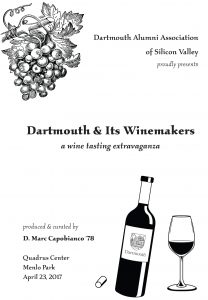1. a gap or missing part, as in a manuscript, series, or logical argument; hiatus.
Loyal readers of the Sostevinobile blog have probably noticed a paucity of entries, so far, for 2017. As in none. This gap, however, has not occurred because Your West Coast Oenophile has been missing in action or confronting his worst case of writer’s block since John Hawkes’ graduate seminar in fiction writing. I have actually started several posts covering my wine forays to Napa, Sonoma, Paso Robles, Amador, Lodi, Santa Cruz, and El Dorado (according to my odometer, nearly 77% of the miles I’ve clocked in 2017 have been for wine tasting forays). Add to that the usual array of trade tastings, although I skipped ZAP for the first time in 20 or so years, as it coincided with Premier Napa, plus I single-handedly produced a wine tasting extravaganza in Menlo Park, featuring some 30 wineries owned by or affiliated with alumni from my undergraduate institute.
 In a word, I’ve been hard-pressed to put words to the page. And since I am so woefully behind in timely coverage of the various events I have attended, let me focus on the various discoveries I have made over the past few months as I have been meandering throughout the state.
In a word, I’ve been hard-pressed to put words to the page. And since I am so woefully behind in timely coverage of the various events I have attended, let me focus on the various discoveries I have made over the past few months as I have been meandering throughout the state.
As they usually do, my journeys began with a swing down to Paso Robles, though this time with one very significant difference: rain. After 5 years of drought, the weather gods seemed determined to atone for their dereliction in a single season, and on the Friday before President’s Day, turned what is normally a 3¼ hour drive down US 101 into a 7+ hour ordeal.
Despite oftentimes feeling as if I were taking my life into my own hands—at one point, almost driving into the Salinas River—I still managed to handle the deluge in stride, and managed to visit quite a number of wineries, while sandwiching in the regional Rhône Rangers tasting. It proved a most revelatory excursion, renewing my acquaintance with Roger Nicolas of RN Estate (not to be confused with Roger Nicholas of Lodi’s Grand Amis) and discussing his transition from the superb Rhône varietals he produces to a Bordeaux focus, including his sublime 2014 Malbec.
Readers here know that I have been championing Malbec as the Next Big Thing in California (along with my declaration of Pinot fatigue). Just before joining Roger for his tasting, I waded through the Adelaida District to join Jim Madsen at Thacher, where The Farm was laboring through its annual day of bottling. Much to my surprise, Santiago Achával was also manning the line alongside his associates. Though we had not met before, we have corresponded over the past several years and have numerous mutual friends, including Manuel Ferrer Minetti, his former partner at Argentina’s renowned Achával-Ferrer. 
To learn from Santiago that The Farm was indeed planning to bottle their own Malbec in Paso Robles—once it met his exacting standards—was an epiphany. Further underscoring this prognostication was my discovery of Tooth & Nail’s 2014 The Fiend, a Malbec blended with 8% Cabernet Sauvignon, 2% Petite Sirah, and 2% Syrah and a revisit with Wally Murray’s Bon Niche, whose 2011 Voûtes/Arches has long been a benchmark Malbec blend. In fact, Wally’s second label, Birdland, is comprised of three mid-range Malbecs and Malbec blends, a further validation of my belief that California is no longer ceding this varietal to the South Americans. The only question that remains is whether Carménère can be far behind.
 I have been referring to this Paso Robles trip as my M&M excursion. True, before the massive proliferation of wineries throughout the AVA, a packet of these candies was my go-to choice whenever I stopped here for the obligatory refill the tank and relieve the bladder before the second leg of my drive to Los Angeles, but this winter, it took on a whole new meaning. Also rising up from relative obscurity among its peer varietals, Mourvèdre, at long last appears to be taking center stage for many Rhône red producers. If GSMs could be likened to a professional basketball squad, Grenache would be Kevin Durant, Syrah—Steph Curry, and Mourvèdre, the overshadowed star of this triumvirate, Klay Thompson. But just as Thompson can manage to eclipse his co-stars every so often, so too can Mourvèdre find its niche as a primary varietal.
I have been referring to this Paso Robles trip as my M&M excursion. True, before the massive proliferation of wineries throughout the AVA, a packet of these candies was my go-to choice whenever I stopped here for the obligatory refill the tank and relieve the bladder before the second leg of my drive to Los Angeles, but this winter, it took on a whole new meaning. Also rising up from relative obscurity among its peer varietals, Mourvèdre, at long last appears to be taking center stage for many Rhône red producers. If GSMs could be likened to a professional basketball squad, Grenache would be Kevin Durant, Syrah—Steph Curry, and Mourvèdre, the overshadowed star of this triumvirate, Klay Thompson. But just as Thompson can manage to eclipse his co-stars every so often, so too can Mourvèdre find its niche as a primary varietal.
The Saturday event at Broken Earth proved, admittedly, a bit of an endurance test, given the decibel level of the concrete antechamber where the Grand Tasting took place. Placards hung from the ceiling celebrate each of the Rhône varietals, though the irony of misspelling “Mourvédre” was not lost. Still, eleven of the participating wineries featured a varietal Mourvèdre bottling, with particular standouts including Adelaida’s 2014 Mourvèdre Signature Anna’s Estate Vineyard, Clautière’s 2012 Estate Mourvèdre, compelling bottlings of the 2014 Mataró from Red Soles, Summerwood’s 2013 Mourvèdre, and the 2014 Mourvèdre from the redoubtable Vines on the Marycrest. Rounding out the assemblage, both Seven Oxen and Rhône virtuoso Tablas Creek offered superb renditions of their 2014 Mourvèdre.
Whether it’s labeled as its Spanish name (Monastrell) or its Catalan nomenclature (Mataró), Mourvèdre has been unheralded as a primary Rhône varietal for far too long on the West Coast. It is most gratifying to see that it is finally getting the measure of respect it deserves. Of course, I could say the same for the vast majority of the 200+ varietals I have sourced for Sostevinobile throughout the West Coast, but that would require a far more comprehensive undertaking than I have time to allocate currently. Still, my final takeaway from Paso Robles was the discovery of a true Gamay—not Valdiguié—the 2015 Stasis Gamay Noir from Rob Murray’s Murmur VIneyard in nearby Santa Maria Valley, an exceptional wine that easily rivaled the 2012 RPM Gamay Noir, my overall favorite wine from that vintage.
After stopping off in Carmel-by-the-Sea, I made it back to San Francisco with barely enough time to brush my teeth and reload my travel bags before heading up to Napa and Sonoma for a five day excursion. In many ways, I concede that the events surrounding Première Napa are more personal indulgence than research; after all, this is primary county-wide showcase of the year and it remains fairly difficult, for the most part, to distinguish, critically, wines that range from very good to phenomenal. Première is about building and cementing relationships, cultivated over the years, in the hope of gaining discrete allocations if and when Sostevinobile becomes able to take on a prestigious reserve list or cater to a private membership within the confines of our facilities.
The other challenge, of course, is the rigid orthodoxy of the Bordeaux strictures to which the vast majority of Napa wineries adhere. Encountering unheralded varietals or non-traditional blends is a rarity in this AVA. Highway 29, the backbone of the Napa Valley, interconnects its most mainstream AVAs: Oak Knoll, Yountville, Rutherford, Oakville, and St. Helena, and along this conduit one tends to find the least variance in deference to the near universal excellence of its Cabernets—not to mention the price per ton Cabernet Sauvignon from here commands. Meanwhile, the more remote regions of the county, like Coombsville and Calistoga, generally seem more willing to delve into other varietals—even those that have fallen into disuse in Bordeaux!
As scarce as Malbec may be in California, the fabled sixth Bordeaux grape, Carménère, is even rarer. Even its most noteworthy producer outside of South America, Yorkville Cellars in Mendocino, seems almost reticent in promoting its varietal bottling. But with little fanfare, the redoubtable John Caldwell has plantings in Coombsville, and what suppose to be a quick visit to discuss obtaining some graftings of Malbec and of Carménère for my Paso Robles clients turned into a 3½ hour bacchanal that only ended because I had to attend a memorial service at the Marin Art & Garden Center in Ross.
I’d like to believe the late Dr. Jim McCole would not have minded my missing his Celebration of Life. Certainly, he would have himself preferred to indulge in the 2014 Rocket Science, Caldwell’s signature bottling of ⅔ Syrah with 7% Cabernet Sauvignon, 7% Malbec, 6% Cabernet Franc, 5% Pinot Noir, 4% Merlot, 3% Tannat, and 1% Carménère, a blend as unconventional as the man behind it. I, in turn, cottoned to the 2012 Gold Cabernet Suavignon and an equally alluring 2014 Silver Proprietary Red, a rare blend of his six Bordeaux varietals, with a 1% dash of Syrah—an homage to 19th Century Claret.
Caldwell is renowned for the meticulously researched, albeit often smuggled, varietal clones grown on his estate, and labels his wines accordingly. The apex of this precision was his 2013 Merlot [Clone 181], along with the 2013 Malbec [Clone 595], but I still delighted most in the 2014 Carménère [Clone 2].
Readers well-familiar with my penchant for rare and obscure varietals will know that I am not satisfied with sourcing a mere six red Bordeaux varietals, and while John has yet to smuggle in cuttings of St. Macaire, both Mt. Veeder’s Progeny and O’Shaughnessy on Howell Mountain have plantings. But like the elusive Planet X, theoretically lurking undetected in the Kuiper Belt, the eighth Bordeaux red, Gros Verdot, has never found its niche in California, at least until now. Indeed, O’Shaughnessy has covertly planted it at their Angwin estateand will be releasing their 8 varietal blend this spring, superseding their famed Howell Mountain Cabernet, renowned for its inclusion of St,. Maciare and Carménère with the major Bordelaise grapes. Now if only Jancis Robinson hadn’t debunked Cabernet Gernischt…
(to be continued)